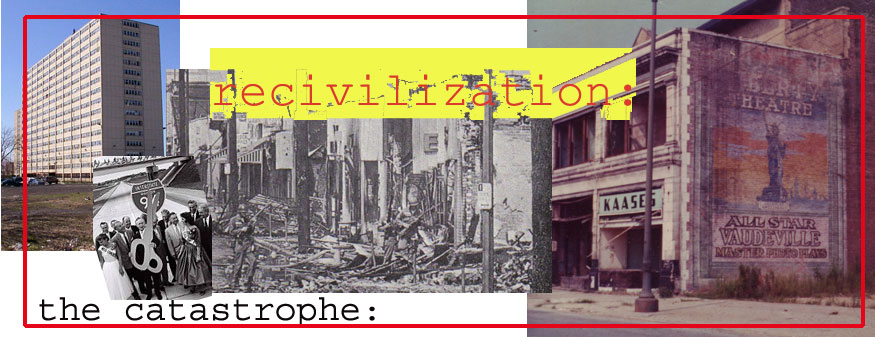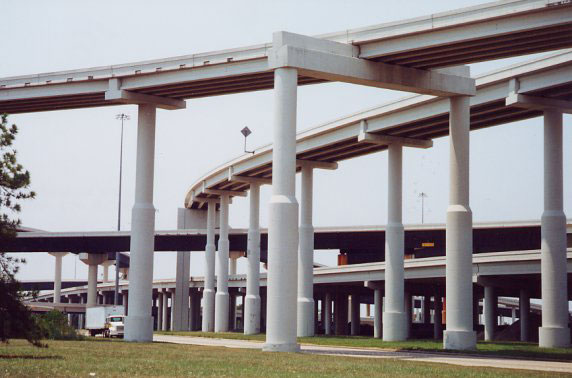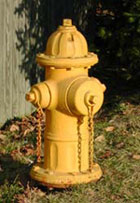

305 the highwaymen's big strike
What nobler agent has culture or civilization than the great open road made
beautiful and safe for continually flowing traffic, a harmonious part
of a great whole life?
-Frank Lloyd Wright, The Living City I lose my car, it's like my legs are cut off... -William Holden in Sunset Boulevard (1950) Some historians have speculated as to how 19th-century America could have been built without the railroads, how steam-powered water transportation and good roads would have done the job of filling a continent just as well. There would be no Atlanta, perhaps, and none of the impetus that railroads provided for iron-based industrialism. Like the railroads, the interstates appeared as quickly and forcefully as they did because a technological innovation in transportation provided an opportunity for profit. A large and politically powerful industrial complex grew up around it, and then used its power to bend public policy to its goals. Similarly, it is certain the United States could have done without the interstates, and pointless to drape an aura of inevitability around them; road vehicles possessed no economic advantage over rail in long-distance freight or passenger travel until the government gave it to them. It might have been done better. Between the wars, when a network of highways was first envisaged, the most thoughtful planners had been among their first and strongest backers. Members of the regional planning movement favored them for their promise of decentralizing cities, and some, such as Benton MacKaye, saw an opportunity for saving both landscapes and townscapes. MacKaye dreamed of the 'townless highway' and the 'highwayless town'; there would be controlled-access roads to separate motor traffic and speed it from one town to another, and public land-use control of the roadsides along the way to ensure that what he called 'motor slums' would not develop. It makes a lovely picture, though of course motor slums are what we got. There's nothing wrong with good roads. The interstate system undoubtedly increased the national prosperity; this biggest public works program in human history might even have justified the cost. The particular contribution of the auto lobby and the highway planners to the Catastrophe was its insistence on ramming them right through the hearts of cities. This was the auto lobby's idea from the start, as shown in the emphasis on highways in the GM Futurama from the '39 Fair (the theme of the entire GM pavilion, inscribed over the entrance, had been 'Magic Motorways'). There is no use analyzing the relative degrees of idealism and cynical manipulation in the effort; the auto men had a vision, at a time when nobody else did. The federal government depended on the industry to provide it and the industry was only too glad to assist. At the time the interstates were being planned, 'Engine Charlie' Wilson of GM, the man who didn't mind saying that what was good for his company was good for the U. S., sat in President Eisenhower's cabinet, and the administrator for highways was Francis DuPont, of the family that has always been GM's biggest stockholder. As a result, what the nation got was not a transportation policy, but a highway policy. All through the war, the auto interests had been churning tirelessly in anticipation of the expected postwar clambake. The Interstate program was actually born in 1944. Originally proposed as 'National Interstate and Defense Highways', exactly what the 'defense' aspect might have been nobody knew- but a little patriotic dressing never hurts a bill in Congress. In the immediate postwar years, the program never really got off the ground; the feds contributed 50% of the costs, with the rest left to the states, but even this generous handout was not enough to get unneeded roads built. Only 1% of the planned mileage was complete by 1952. It just wasn't good enough. The road lobby's answer emerged as the Highway Act of 1956. This time, a devilishly clever 90-10 split, with the 90% coming from a new highway trust fund built on gas taxes, made it almost impossible for states to refuse any road its highway planners laid out. As in 1944, the program was dressed up in star-spangled hogwash; the roads were supposed to be 'defense highways', though the planners showed no evident embarrassment when someone noticed that the projected standard height for overpasses was too low for the roads to be used by many army vehicles. Highways were the transportation counterpart of the other major federal initiative, urban renewal. Dissident planner Robert Goodman called the machinery behind them both the 'urban-industrial complex': big government in perfect harmony with big business and big thinkers. Architects made themselves willing accomplices; while a few led fights against the most destructive roads, the big shots were helping them along. Firms like Skidmore, Owings Merrill racked up millions in consultant fees, while scatterbrained Modernists sang the praises of the new roads-hear the chairman of the Yale School of Architecture in 1965, musing how 'freeways could be the real monuments of the future, the places set aside for special celebration by people able to experience space and light and motion and relationships to other people and things at a speed that so far only this century has allowed'. Any major undertaking in a democratic state requires a major propaganda campaign and a minimum tolerance for objections. Under the conditions of the time, the debate was conducted not as public discussion, but as a public relations campaign with a pre-ordained outcome; highways would not have been proposed if they could not be sold like soap. The lobby worked all the levers, brazenly spinning its howling fairytales to the nation: highways would reduce traffic deaths, they would defeat congestion and revive downtowns, they would give cities cleaner air and lovely green parkways. The ultimate weapon in its arsenal of whoppers was the very idea of highways' inevitability. They were the future, and you were either with them or in the way. Meanwhile, in public meetings, road planners and administrators endured the slight inconvenience of sitting and listening to the complaints of community groups and individual citizens for an hour or two, with the consolation of knowing that they could simply ignore them afterwards. From the beginning, they always got their way, and there is no record of public objections convincing them to change their minds on any but the most trivial points. The cities themselves fell for it. A public works windfall at almost no cost to them made the argument irresistible. The owners of the big stores downtown were especially vocal in their support, convinced that urban highways would bring them more business, A few planners noticed the cruel irony: 'Is there any instance in this country where a new expressway or highway or elevated street hasn't invited so much additional traffic as to almost immediately create congestion?' asked Walter Bluecher, executive director of American Society of Planning Officials in 1953. Noting the highways' inevitable impetus to decentralization of cities, he continued, ' I marvel that downtown merchants are usually in the van in urging their construction. Polls always showed that road improvements were as popular as apple pie, but a national debate on just what sort of road improvements never happened. Neither were any alternatives offered, though the public might well have preferred them. A Fortune survey in 1958 found that most automobile commuters, then facing slow commutes on city streets, would have preferred a 'new rapid transit system' to 'new highways and expressways'; 70% of drivers said that given the choice, they would 'seriously consider switching to a first-class transit system'. The process under which highways were designed and routes plotted demonstrates clearly enough the disregard decision makers had not only for the public, but for city planners. To the public mind, planners existed to make pretty models of ideal cities. For something grown-up like highways they would never do. Already, as mandated by the federal government back in the 30's, states and counties possessed highway departments ready to take on the job. The new profession of the highway engineers was dedicated to a single goal, that of facilitating as much traffic as possible, and it had a scientistic solution for every road planning problem. Traffic counts and 'desire lines' (interview research to determine the origins and destinations of trips by area) were part of the impressively scientific apparatus by which new highway proposals were determined; in the end, these only confirmed what every city driver already knew. The intellectual basis of it all, laid out in such bibles of the profession as the 'Green Book' or the 'Highway Capacity Manual' of the Transportation Research Board makes for chilling reading-a pedestrian is defined as a 'traffic flow interruption'. The Green Book was the work of the American Association of State Highway and Transportation Officials (AASHTO); it turned the process of design to one end only: increasing speeds. Roads had to get wider, so the trees, or anything else within 15 feet of the roadway, came down. If you had a historic old stone bridge, AASHTO wanted it demolished. Decorative street lamps? AASHTO insisted you replace them with ugly ones. And if you wanted any federal funding, you had to do whatever AASHTO said. Architect Victor Gruen (in The Heart of Our Cities) understood the real nature of highway engineering, and the self-perpetuating careerism behind it. 'This is not astonishing, if one considers that the traffickist is an expert and specialist who wishes to perpetuate the problem from which he is making a living. Toward the end of keeping his beloved specialty a continuous enterprise, he very carefully plans his efforts in such a manner that they create new and even more fascinating problems...The traffickists have hypnotized us into believing that traffic is an elemental act of God or nature, like an earthquake, a flood or a hurricane; something which only the expert, with his God-given power and insight, can dare to tangle with'. The important decisions to be made lay in the design of the road and settling the exact route. In design, highway engineers applied the same standards to city and country alike, and the standards were rock-bottom. Wherever the highway met the city, at exit and entrance ramps, neighborhoods were disfigured with shabby concrete walks, curbs and overpasses, chain-link fences, aluminum crash rails, minimal landscaping or none. City streets sprouted huge, green, garishly illuminated directional signs on 30-ft aluminum poles, designed to be seen a quarter-mile away. The Interstate planners gave a cold slap in the face to every town; nothing quite like them had happened since the invention of the el train, and those had only blighted a very few cities. The Interstates were everywhere, and everywhere the same. Through them the planners and the federal government sent city people a message: nothing really matters any more, and the neighborhoods the highways tore through were fit only for leaving. As for route planning, the engineers' sole consideration was keeping down the cost of land acquisition. So highways continued to be built through the public parks and any other vulnerable space. Often this was old industrial areas or docks; in this way Philadelphia, Pittsburgh, Cincinnati, Louisville and many other cities lost access to their waterfronts, and valuable land that could have been redeveloped for apartments or parks became a wasteland. Louisiana highwaymen wanted to run one right next to the Vieux Carré levee in New Orleans, destroying the French Market in the process, before one of the first successful anti-highway campaigns stopped them. One basic tenet of the engineers' theory was the downtown loop, or 'inner belt', intended to distribute traffic around the center; these were usually built very close to the business core, devastating the fringes of downtown and cutting it off forever from its surrounding neighborhoods. The theory was just as rough on residential areas. Highway planners did not concern themselves with the fabric of the city. The only question to them was the most direct and cost-efficient routes; if the roads cut coherent neighborhoods into pieces, and plowed diagonally through the middle of commercial strips, that was not their problem; for the engineers, the city was a blank slate, and they had the power to carve it up any way they wished. If local leaders seldom spoke out against engineering barbarism, they would at times help insert some ulterior motives into the planning process. Highways everywhere were pressed into service in the racial frontier wars, either consciously constructed as boundaries, or run through the heart of the most densely populated black areas in hopes of wiping them out completely for future redevelopment. Chicago's Dan Ryan Expressway found a course that artfully separated the South Side 'Black Belt' from white neighborhoods such as Bridgeport (just coincidentally the home of Mayor Daley and other machine leaders). In Detroit, the Chrysler Freeway was plotted to run right down the black business area along Hastings Street, destroying scores of black-owned businesses and neighborhood institutions. Blacks could run but they couldn't hide; when the black middle class settled a new area around 12th Street on the West Side, the Lodge, Jefferies and Edsel Ford Freeways appeared, chopping the neighborhood into shreds. Big interchanges were carefully planned to wipe out entire neighborhoods if they stood close to land that was deemed potentially valuable. Just blocks from the state capitol in Atlanta stood Summerhill, the 'Mecca of Atlanta', a thriving, mostly black neighborhood that was home to some of the city's leading citizens; of 12,500 residents, 10,000 were forced out. No one kept any conclusive statistics on how many people have been displaced for highways since 1956, although the number would be in the millions. One of the most destructive roads, Robert Moses' Cross-Bronx Expressway, accounted for over 100,000 all by itself. For the first fifteen years, people forced from their homes were not even offered relocation assistance. Against the combination of the federal, state and local governments, neighborhoods could hardly mount a defense. The few cases where a highway was defeated came in high-profile, high-value city center areas, such as central San Francisco or Manhattan, or else in wealthy suburbs such as Cleveland's Shaker Heights. Most neighborhoods didn't even try, a tribute to the bovine resignation with which Americans of the 50's and 60's had come to accept being shunted around.* The urban Interstates radically changed the form of American cities and their way of living. As they devastated older neighborhoods, they redirected their inhabitants to distant suburban areas, while initiating huge volumes of traffic. They encouraged shopping and business to relocate on the fringes, and the new poles of activity that resulted looked nothing like the old. Instead of proper city streets, places to be, with a mixture of activities, the new model provided broad roads lined with solid ranks of parking lots. Some did not even bother with sidewalks; the car, not the human, was now the actor on the urban stage. The Interstates cannot be held entirely
responsible for this total abdication of urban design. Trends that had
started before the war reached their culmination in these years: in the
older neighborhoods and downtown, the erosion of public space and
neighborhood centers increased dramatically. The system as a whole,
along with air travel, killed off inter-city railroads, along with the
complex of hotels, restaurants and other facilities that made downtown
the city's front door. It was increasingly clear that the heavily
subsidized creation of the new automobile city intended the destruction
of all existing communities and ways of life, but Americans accepted it
with the same dull fatalism. This was Progress. * any conclusive statistics: the numbers could be found, hidden deep inside federal and local records. It would be a useful task for a stat-freak historian or urban studies scholar to look more closely at the total effect of federal programs 1945-1980. I suspect they would find: a) that highways, urban renewal and housing projects (especially HUD's section 235) resulted in a serious population loss not only from the sites cleared, but from the surrounding neighborhoods distressed by the interventions; and b) that the total figures would represent a shockingly large percentage of declining cities' total population loss, most likely a third or more. |
|

|